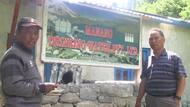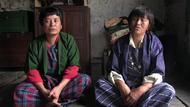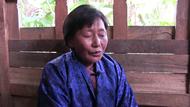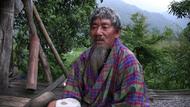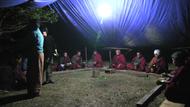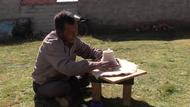Video Overview
A documentary on traditional arga roof construction.
- རྒྱས་བཤད་བྱེད་མཁན Narrator 解说ཆ་སྙོམས་རྒྱ་མཚོའི་ངོས་ལས་མཐོ་ཚད་སྨི2800ཡན་གྱི་ཧི་མ་ལ་ཡའི་ས་ཁུལ་དུ་ཁང་པའི་ཐོག་ངོས་སྙོམས་སུ་བསྐྲུན་པ་ནི་ཁུལ་དེའི་ཁང་པ་བཟོ་སྐྲུན་བྱེད་སྐབས་ཀྱི་ཁང་ཐོག་གི་རྣམ་པ་གཙོ་བོ་དེ་ཡིན།In the Himalayan region, at altitudes at more than about 2800 metres, the flat roof construction is the predominant form of roof.在平均海拔2800米以上的喜马拉雅地区,平顶是该地区房屋建筑的主要屋顶形式。
- ེས་མ་ཚད་ཁང་པ་མང་ཆེ་བའི་ཁང་ཐོག་གི་ཕྱི་ངོས་དང་ཆུ་འགྲོ་ཚང་མ་འདམ་ལས་གྲུབ་པ་ཡིན། /Most of the flat roofs are still built with earth as the upper layer and the water disposal surface. /且大部分屋顶的表面和水处理层都由泥土制成。/
- གོ་ལ་ཧྲིལ་པོའི་ཡུལ་གྲུ་གང་ས་གང་དུ་དེ་དང་དེ་འདྲ་བའི་ཁང་ཐོག་ས་རྒྱུ་ལས་གྲུབ་པ་མང་དག་ཅིག་ང་ཚོའི་མིག་ལམ་དུ་མཐོང་ཐུབ། /Similar forms of earthen roofs with different variations we may find all over the globe. /在全球各个角落我们都可以发现相似的土制结构的屋顶。/
- རྒྱུན་མཐོང་གི་ས་རྒྱུའི་གྲུབ་ཆ་གཙོ་བོར་བྱེད་པའི་དམིགས་བསལ་ཅན་གྱི་ཁང་ཐོག་གི་རྣམ་པ་དེ་རིགས་ཁུལ་འདིར་རྒྱུན་ཆགས་སུ་བཀོལ་སྤྱོད་བྱེད་བཞིན་ཡོད་པ་ནི“རྡོ་ཨར་ཀ” ཞེས་རྡོ་དམིགས་བསལ་ཅན་ཞིག་ཡོད། /There is a particular type of a flat roof which arise from the common earthen type since it is not made of earth, but with a specific stone. It is called the argastone./由这种常见的土制结构衍生出的一种特殊的屋顶形式在当地应运而生,即“阿嘎石”,一种特殊的石头。/
- ང་ཚོ་ཧི་མ་ལ་ཡའི་ཁུལ་ཞིག་ཏུ་ཆད་འགྲོ། /Which leads us up into the Himalayas. /让我们进入了喜马拉雅地区。/
- ལས་མི་རྣམས་ཀྱིས་ས་གནས་དེ་གའི་ཨར་གཞས་གཏོང་བཞིན་འདུག /[Workers singing in local dialect]/[工人在唱诵当地的阿嘎歌]/
- རྒྱས་བཤད་བྱེད་མཁན Narrator 解说བོད་ལྗོངས་སུ་རྡོ་ཨར་ཀ་ནི་ས་གནས་དེ་གའི་དགོན་པ་བཞེངས་པ་དང་། ཡུལ་མིའི་སྡོད་ཁང་བསྐྲུན་སྐབས་ཀྱི་ས་མཐིལ་དང་། ཁང་ཐོག་བཟོ་སྐྲུན་བྱེད་པའི་རྨང་གཞིའི་རྒྱུ་ཆར་བཀོལ་གྱི་ཡོད།/In Tibet, arga was used as base material for floor and roof constructions for representative religious and also residential buildings./在西藏,阿嘎石常被作为修建当地寺庙和民居建筑的地板和屋顶的基础材料。/
- ས་མཐིལ་དང་ཁང་ཐོག་ནི་བཟོ་སྐྲུན་རྣམ་པའི་ཐད་མཚུངས་པ་དང་། མི་མཚུངས་པ་ནི་ས་མཐིལ་གྱི་ངོས་ལ་ཉིན་ལྟར་ཕྱིས་བདར་བཏང་བས་ཤིན་ཏུ་འཇམ་པོར་གྱུར་ཡོད། /Floors and roofs were erected in the same manner. The difference was in the daily treatment of the surface of the floor, which was kept shiny by regularly polishing the surface. /地板和屋顶的修建在形式上一样,其不同在于地板的表面由于每天的擦拭而非常光滑。/
- དུས་རྒྱུན་གྱི་གཙང་སྦྲའི་ལས་དོན་ཁྲོད། དཔེར་ན་ན་གཞོན་དགེ་འདུན་པས་འབྲུ་བླུགས་པའི་སྒྱེའུས་ས་མཐིལ་སྟེང་ཕར་འཕུར་ཚུར་འཕུར་གྱིས་ས་མཐིལ་འོད་ཐིང་ཐིང་ཡོང་བ་བྱེད་ཀྱི་ཡོད། /This work was conducted, for instance, by a young lama during a daily puja. For polishing, a woolen sheepskin filled with barley was dragged over the surface. /在日常的清洁工作中,例如年轻的喇嘛会使用放置了青稞的羊皮袋子在地板上拖拽来达到擦拭的效果。/
- མ་མཐར་ཡང་ཨར་ཀའི་ས་མཐིལ་སྟེང་ཕར་ཚུར་འགྲོ་ཙམ་འགྲོ་ཙམ་བྱེད་ནའང་ས་མཐིལ་རྒྱུན་རིང་བཀོལ་སྤྱོད་ཐུབ་རྒྱུར་ཕན་པ་ཡོང་ཐུབ། /At least walking on an arga floor keeps it durable for a longer period./至少在阿嘎地板上走动也能帮助地板使用更长的时间。/
- ད་ལྟའི་བར་དུ་ང་ཚོས་སྔར་བཞིན་བོད་ལྗོངས་ཀྱི་དབུས་རྒྱུད་དང་མངའ་རིས་ས་ཁུལ་དུ་ཉར་ཚགས་ཤིན་ཏུ་ལེགས་པའི་ཨར་ཀའི་ས་མཐིལ་མཐོང་ཐུབ། དཔེ་མཚོན་ནི་ལྷ་སའི་གཙུག་ལག་ཁང་ཡིན། /Still we may find well-maintained examples of arga floors in central Tibet and also in Ngari. Exemplarly, in the Jokhangs of Lhasa or Khorcha. /至今我们仍能在西藏的中部或阿里地区发现保存良好的阿嘎地板,典型的例子如拉萨的大昭寺。/
- སི་པི་ཏི་དང་ལ་ཧོའི་ས་ཁུལ་དུ་སྲོལ་རྒྱུན་གྱི་བཟོ་རྩལ་དེ་རིགས་ནུབ་ཟིན། འོན་ཀྱང་ལ་དྭགས་ཁུལ་དུ་ས་གནད་དེ་གའི་ཆོས་ལུགས་དང་ཡུལ་མིའི་སྡོད་ཁང་གི་བཟོ་སྐྲུན་ཁྲོད་ང་ཚོས་ཨར་ཀའི་ས་མཐིལ་རྙེད་ཐུབ། དཔེར་ན་སི་ཕི་ཐུའུ་དགོན་དང་བྲག་གསུམ་དགོན། བླ་མ་གཡུ་རུ་དགོན་བཅས་སོ། །/In Spiti and Lahaul, this tradition could not be traced. While in Ladakh, a few examples, religious as well as residential, may be found, for example, in the monasteries of Spituk, Baso, or Lamayuru. /在斯比蒂和拉霍地区,这种传统工艺已经消失。但在拉达克,我们仍然能够在当地的一些宗教和民居建筑中找到阿嘎地板,例如斯皮图寺,巴松寺和喇嘛玉如寺。/
- ས་ཁུལ་དེར་བྲག་རྡོ་ཧྲོབ་ཧྲོབ་མང་པོ་དང་ཚབ་བྱེད་བཟོ་རྩལ་ཁག་གཅིག་ལས་སྲོལ་རྒྱུན་བཟོ་རྩལ་དེ་རིགས་ཧི་མ་ལ་ཡའི་ནུབ་རྒྱུད་ས་ཁུལ་ལ་ཉམས་རྒུད་དུ་འགྲོ་འགོ་ཚུགས་པ་གསལ་པོར་མངོན་བཞིན་ཡོད། /In this region, many crags, partial replacements and a certain negligence point out the vanishing of this tradition in the western Himalayas. /在这一地区,很多岩石碎块和部分替代工艺都显示了这一传统工艺在喜马拉萨西部地区的没落。/
- དེས་ན་ཨར་ཀའི་བཟོ་རྩལ་འདི་ཉིད་སྲོལ་རྒྱུན་གྱི་བཟོ་སྐྲུན་བྱེད་ཐབས་ཤིག་ཡིན་པའི་ངོས་ནས་སྔར་བཞིན་བོད་ལྗོངས་ཀྱི་དབུས་རྒྱུད་ས་ཁུལ་དུ་རྒྱ་ཁྱབ་ཏུ་སྤྱོད་བཞིན་ཡོད།/Therefore, the center of this method as a still-living tradition remains in central Tibet. /然而,阿嘎工艺作为传统建筑方法仍然广泛流行于西藏中部地区。/
- [ལས་མི་རྣམས་ཀྱིས་ས་གནས་དེ་གའི་ཨར་གཞས་གཏོང་བཞིན་འདུག]/[Workers singing in local dialect]/[工人在唱诵当地的阿嘎歌]/
- རྒྱས་བཤད་བྱེད་མཁན Narrator 解说ཕན་ཚུན་ཞིབ་བསྡུར་བྱས་ཚེ། ཧི་མ་ལ་ཡའི་ས་ཁུལ་དུ་སྔར་བས་དར་ཁྱབ་ཆེ་བའི་སྲོལ་རྒྱུན་གྱི་ས་རྒྱུ་ལས་གྲུབ་པའི་ཁང་པ་ཐོག་སྙོམས་དང་། ཨར་ཀའི་བཟོ་རྩལ་ལ་བརྟེན་ནས་བསྐྲུན་པའི་ཁང་ཐོག་གི་ཁྱད་པར་གཙོ་བོ་ནི་བཟོ་སྐྲུན་གྱི་རྒྱུ་ཆ་སྟེ། རྡོ་དང་འདམ་ཡིན། /The basic difference between an arga roof and the traditional earthen flat roof, which is the most common roof construction over the Himalayas, are the used materials--stone or earth, respectively. /相比较于在喜马拉雅地区更为流行的传统土制结构平顶,通过阿嘎工艺修筑的屋顶主要区别在于使用的建筑材料 - 石头和泥土。/
- ཨ་དཀར་བཟོ་རྩལ་དེས་སའི་ཕྱི་ངོས་དང་གྲུབ་ཚུལ་ཕལ་བའི་བང་རིམ་གྱི་ཐག་གཅོད་ཐད་ལ་དམིགས་བསལ་གྱི་རེ་བ་ཡོད།/Arga requires a different treatment of the subconstruction and of the surface. /阿嘎工艺对于地面表面和次结构层的处理上有特殊的要求。/
- འཛམ་གླིང་གི་ས་གནས་མང་པོ་ཞིག་གི་ཁང་ཐོག་བཟོ་བཀོད་སྒྲིག་གཞི་དང་འདྲ་བར། སྲོལ་རྒྱུན་གྱི་ས་རྒྱུ་ལས་གྲུབ་པའི་ཁང་ཐོག་གི་སྒྲིག་གཞིར་གཙོ་བོ་ཤིང་ལས་གྲུབ་པའི་སྒྲིག་གཞི་ཕལ་པའི་བང་རིམ་དང་། དེའི་འོག་ཏུ་རླུང་འགྲོའི་བང་རིམ་ཞིག་ལས་གྲུབ་པ་ཡིན། /The common earthen roof is similar to roofs which we may find in other parts of the world, with a wooden subconstruction resting on branches or wooden planks, and the breathable organic layer below. /和世界其它很多地方的屋顶建筑结构相似,传统的土制结构屋顶主要包括木质的次结构层和其下透气的有机层组成。/
- སྔ་དུས་སུ་ཨར་ལས་ཀྱི་རྒྱུ་ཆ་ཡོད་ཚད་ནོར་ནག་གིས་དབོར་འདྲེན་བྱས་པ་ཤ་སྟག་རེད་།/In earlier days, the material was carried on the back of yaks. /早期,所有的建筑材料都是由牦牛来运送。/
- 2014ལོར་དགེ་ལུགས་པའི་གསང་སྔགས་སློབ་གླིང་རྒྱུད་སྨད་གྲྭ་ཚང(རྒྱུད་སྨད་གྲྭ་ཚང) གི་ཨར་ཀའི་ཁང་ཐོག་བསྐྱར་སྐྲུན་ཆ་ཚང་ཞིག་བྱས་པ་རེད། གཙུག་ལག་ཁང་གི་ཁང་ཐོག་ཁག་གཅིག་ཀྱང་ལོ་དེར་བསྐྱར་སྐྲུན་བྱས་པ་རེད།/In 2014, the arga roof of the Gyümé Dratsang, a Tantric college of the Gelukpa school, was completely renewed, and the roof of the Jokhang was partially repaired. /2014年,格鲁派密宗学院下密院(举麦扎仓)的阿嘎屋顶进行了完整的重建。大昭寺的部分屋顶也在当年进行了重建。/
- བརྙན་ཐུང་ནང་ལྷ་ས་གྲོང་ཁྱེར་དུ་གནས་པའི་དགོན་སྡེ་དེ་གཉིས་ཀྱི་ཨར་ཀའི་ཁང་ཐོག་བསྐྱར་སྐྲུན་བྱས་ཚུལ་ངོ་སྤྲོད་བྱས་ཡོད།/Both objects, located in Lhasa, have been part of this documentation. /片中介绍了座落于拉萨市的这两座寺院阿嘎屋顶重建情况。/
- ཨར་ཀའི་ཁང་ཐོག་གི་ས་ངོས་ཀྱི་སྤུས་ཚད་བཟང་ངན་ནི་གཙོ་བོ་བེད་སྤྱོད་བྱས་པའི་རྡོ་ཧྲུག་གྲངས་འབོར་དང་ལས་མིས་ཧང་རྡོ་བཞུས་རྗེས་རྡོ་ཧྲུག་ཡང་ཡང་བརྫངས་པའི་སྟུག་ཚད་ལ་རག་ལས་ཡོད། /The different qualities of arga, primarily depending on the amount of pebbles, making the effort of ramming higher, since they are hard to crush. /阿嘎屋顶地面的质量优劣主要取决于使用的碎石数量和人工反复夯打后石子填塞的密度大小。/
- སྐབས་འགར་ཆོས་ལུགས་ཀྱི་ཆོ་གའི་དགོས་མཁོ་གཞིར་བཟུང་། ཤིང་རྩའི་སྦྱངས་ཁུ་ཨར་ཀའི་ཁྲོད་བླུགས་ནས་ཨར་ཀའི་ཚོན་མདོག་ངུར་སྨྲིག་མངོན་པར་བྱེད་ཀྱི་ཡོད།/For religious purpose, the sap of a specific kind of root was used as an additive for reddish-pink coloring. /有时根据一些宗教仪轨,某些树根的提取液作为添加剂使用在阿嘎土中使之呈现绛红色。/
- དགོན་སྡེ་གཉིས་སུ་སྤྱོད་པའི་ཨར་ཀའི་ས་ཚང་མ་ཆུ་ཤུར་རྫོང་གི་ཡིན་ཞིང་ས་མདོག་སྐྱ་ནག་ཡིན།/The arga at both sites was brought from Chushur. The material itself is of a greyish color. /两处寺院使用的阿嘎土都是来自曲水县,颜色呈灰黑色。/
- ས་རྒྱུ་ལ་གཞིགས་ནས་དབྱེ་ཞིབ་བྱས་ཚེ། ང་ཚོས་ཨར་ཀའི་ནང་དུ་ཀེལ་འདུས་རྡོ་མང་པོ་ཞིག་དང་། རྡོ་དཀར་གོང་དང་ཁྲང་རྡོ་ཉུང་ཤས་ཡོད་པ་རྟོགས་ཐུབ། /The mineral analysis shows a high content of calcite and a small proportion of quartz and feldspar. /根据土质分析,我们发现阿嘎土中含有大量的方解石和少量的石英、长石。/
- རྒྱུད་སྨད་གྲྭ་ཚང་གི་སྨི་ངོས་སྙོམས་གྲུ་བཞི་མ700 ཙམ་གྱི་ཨར་ཀའི་ཐོག་ཁ་བསྐྱར་སྐྲུན་གྱི་ལས་གྲྭའི་ཁྲོད། ལས་མི80 ནས100ཙམ་གྱིས་ཞོགས་པ་ཆུ་ཚོད་བརྒྱད་པ་ནས་ཕྱི་དྲོའི་ཆུ་ཚོད་ལྔ་པ་བར་བསྟུད་མར་ལས་ཀ་བྱེད་དགོས། /For the renewed roof area of the Gyümé Dratsang, with about 700 square meters, eighty to one hundred workers are necessary and were continuously working from morning at 8 until evening at 5. /在下密院近700平米的阿嘎屋顶重建工程中,需要80到100名工人连续从早上8点工作到下午5点。/
- རྒྱུ་ཆ་དག་གནོན་བཙིར་བྱས་པའི་དབང་གིས་ལྷག་ཏུ་ལྩི་བ་དང་། བསྟུད་མར་ཉིན་འགའི་རིང་ཨར་ཀ་ཡང་ཡང་བཅག་པ་པའི་གཡོ་འགུལ་གྱིས། ས་རྒྱུའི་གྲུབ་ཆའི་ཁང་ཐོག་ཁྲོད་ཀྱི་གྲུབ་ཚུལ་ཕལ་པས་ཨར་ཀའི་ཁང་ཐོག་བསྐྲུན་པའི་དགོས་མཁོ་སྐོང་ཐུབ་ཀྱི་མེད། /Since the material is heavier in a compressed condition, and due to the vibrations during a several days lasting ramming process, the common subconstruction known from earthen roofs is not sufficient. /由于材料在压缩条件下更重,以及连续多天反复夯打过程中所产生的震动,土制结构屋顶中的次结构不足以满足阿嘎屋顶的需求。/
- ཤིང་གདུང་སྟེང་བཀབ་པའི་རྡོ་ལེབ་ནི་མེད་དུ་མི་རུང་བའི་ཆ་ཤས་ཤིག་ཡིན། ཨར་ཀའི་ས་རིས་ཀྱི་མཐུག་ལོས་ནི་གཙོ་བོ་སྤུས་ཀ་ལེགས་ཉེས་ཇི་ལྟར་དགོས་མིན་ལས་གཏན་འཁེལ་བྱས་པ་ཞིག་ཡིན། /Stone slabs, resting on wooden beams, assume the required static role. The amount of layers of arga depends on the required quality. /覆盖在木梁上的石板材是必不可少的部分。阿嘎土层的多少主要由所需质量优劣而决定的。/
- ཨར་ཀ་སྙོམས་པོར་བཙིར་གནོན་བྱེད་པ་དང་། དེ་བཞིན་ལྡེམ་ཆ་ལེགས་པའི་ཁྱད་ཆོས་བཟང་པོ་ལྡན་པས། ཁང་པའི་ཐོག་ཁར་ཀ་གདུང་གི་གནོན་ཤུགས་ཕོག་ནའང་རྡིབ་མི་སྲིད།/The saying goes, that in the case of the buckling of the pillar below, the roof does not collapse due to the homogeneous and elastic quality of the rammed arga. /由于阿嘎石均匀挤压以及其具有良好的弹性特征,屋顶即使承受建筑柱梁压力也不会坍塌。/
- [ལས་མི་རྣམས་ཀྱིས་ས་གནས་དེ་གའི་ཨར་གཞས་གཏོང་བཞིན་འདུག][Workers singing in local dialect]/[工人在唱诵当地的阿嘎歌]/
- རྒྱས་བཤད་བྱེད་མཁན Narrator 解说གོམས་པ་དང་པོ་ནི། ཐོག་མར་འདམ་གྱི་བང་རིམ་མཐུག་ཚད་ལ་ལིའི་སྨི10 ཙམ་ཞིག་བཟོ་དགོས། /As a first step, a layer of mud, mostly collected from the fields, is rammed with a thickness of about ten centimeters. /作为第一步,首先将泥浆层打制成约10厘米厚。/
- དེ་རྗེས་ལས་བཟོ་པས་ཨར་ཀའི་རྡོ་བལྟབས་རིལ་གྱིས་སིལ་ནས་མཐུག་ཚད་ལིའི་སྨི10ནས་14ཙམ་གྱི་བང་རིམ་ཞིག་བཟོ་དགོས། /After that, the arga is thrown on that subconstruction with a layer of thickness of about ten to fourteen centimeters, and crushed by heavy rollers made of stone. /其次,工人将阿嘎石用石制的滚筒碾压成10到14厘米厚的次结构层。/
- བཀོལ་སྤྱོད་བྱེད་པའི་ཨར་ཀའི་རྡོ་དག་ལིའི་སྨི2ནས4ཙམ་གྱི་ཞེང་བཟོ་དགོས། གནོན་སིལ་བྱེད་པའི་བརྒྱུད་རིམ་ཁྲོད་ལས་བཟོ་རྣམས་ཀྱིས་ཟམ་མི་ཆད་པར་ཨར་ཀའི་རྡོའི་ཁྲོད་ཆུ་བླུགས་དགོས། /The arga stones, with an approximate size between two and four centimeters, are crushed while pouring them with water. /使用的阿嘎石多为2到4厘米宽,在碾压的过程中,工人不断在阿嘎石中注入清水。/
- ཆུ་བླུགས་པ་དེས་གནོན་སིལ་གྱི་བརྒྱུད་རིམ་ཇེ་མགྱོགས་སུ་འགྲོ་ཐུབ། འོན་ཀྱང་ཚང་མ་གཤེར་འགྱུར་བྱེད་མི་རུང་། /It is the water which makes their crushing easier but they are of such a consistence that they are still not liquified. /清水的使用会加速碾压的过程,但又不至于使其完全液化。/
- བླུགས་བྱེད་ཀྱི་ཆུའི་སྤུས་ཚད་ཀྱང་ཧ་ཅང་གལ་འགངས་ཆེ་སྟེ། ཤོད་སྲོལ་ལྟར་ན་སྐར་མ་རི་ཥིའི( ཀརྨ་སྟོད་པ)སྐབས་ཆུའི་སྤུས་ཚད་ལེགས་ཤོས་སུ་བརྩི་བཞིན་ཡོད།The quality of the water is known as important, and said to be best during Karma Düpa. /使用的清水的质量非常重要,据说在沐浴节(嘎玛堆巴)期间取得清水质量最优。/
- ཀརྨ་སྟོད་པ་སྟེ། སྐར་མ་རི་ཥྀ་ནི་བོད་རིག་པའི་སྐར་རྩིས་ལ་འཁོད་པར་གཞིགས་ན། གཙོ་བོ་བོད་ཟླ་བརྒྱད་པར་ཐོན་གྱི་ཡོད།/Karma Düpa is the name of a star. According to Tibetan calendar, it appears in the month of August. /嘎玛堆巴即弃山星,根据藏族历法记载,主要在8月份出现。/
- བོད་རིགས་མི་རྣམས་ཀྱིས་ཟླ་འདིིའི་རིང་གི་ཆུ་ནི་ཆུ་སྤུས་ལེགས་ལ་དྭངས་ཤིང་གཙང་བས་དུས་འདིར་འཁྲུས་བྱས་ཚེ་ནད་རིགས་བཞི་བརྒྱ་རྩ་བཞི་སེལ་ཐུབ་པའི་ཡིད་ཆེས་བྱེད་ཀྱི་ཡོད། /The Tibetan people consider this month's water as clean and pure water, and being good for health and taking a bath. /藏族人们相信这个月的水质是最为干净清澈的,期间沐浴有利于消除百病。/
- གལ་ཏེ་ཆུའི་སྤུས་ཚད་ཞན་ཚེ། ཨར་ཀའི་འབྱར་འདྲེས་ཀྱི་ཚད་ལ་ཤུགས་རྐྱེན་ངེས་ཅན་ཞིག་ཐེབས་ཀྱི་ཡོད། /Low quality of water reduces the adherence of the stones. /如果水质差,则会很大程度上影响阿嘎石的粘合度。/
- ཉིན་གཅིག་ནས་གཉིས་བར་བལྟབས་རིལ་གྱིས་གནོན་བཙིར་བྱས་རྗེས་གྱང་རྒྱུག་གི་ལས་རིམ་དངོས་སུ་སུ་འགོ་ཚུགས་པ་རེད།/After a rough crushing with the roller, which lasts about one to two days, the ramming process starts. /经过1到2天滚筒的碾压之后,夯打工序正式开始。/
- ཅུང་ངོས་སྙོམས་པའི་ས་ངོས་ལ་མཚོན་ན། ལས་བཟོ་པ་ཚོས “ བོ་རྡོ”ཞེས་པའི་ལག་ཆ་ཞིག་བཀོལ་གྱི་ཡོད། “ བོ་རྡོ” ཞེས་པ་ནི་ཚངས་ཐིག་ལ་ཕལ་ཆེར་ལིའི་སྨི14ལས་གྲུབ་པའི་རྡོ་ལེབ་གཅིག་གི་ནང་དབྱུག་པ་རིང་པོ་ཞིག་བཙུགས་པ་ལས་གྲུབ་པ་རེད།/For flat surfaces, the so-called okdo is used. This is a flat stone with an average diameter of about fifteen centimeters fastened at the bottom end of a stick. /对于较为平坦的地面,工人们使用一种叫“沃多”的工具。“沃多”是在一块直径大概14厘米左右的扁圆形的石块中插入一根长木棒而成。/
- [ལས་མི་རྣམས་ཀྱིས་ས་གནས་དེ་གའི་ཨར་གཞས་གཏོང་བཞིན་འདུག]/[Workers singing in local dialect]/[工人在唱诵当地的阿嘎歌]/
- རྒྱས་བཤད་བྱེད་མཁན Narrator 解说ཟླུམ་དབྱིབས་སམ་རྒྱ་ཁྱོན་ཅུང་ཆུང་བའི་ཕྱི་ངོས་ལ་ལས་བཟོ་པ་རྣམས་ཀྱིས་ཤིང་ལས་བཟོས་པའི་རྡུང་བྱེད་ཡོ་བྱད་གཅིག་སྤྱོད་བཞིན་པ་དེར“ འབོར་ཏོག”ཟེར། /For smaller surfaces like cracks and also for round surfaces like parapet walls, a wooden beater made of hard wood, the bedo, is used. /对于圆形或较小面积的表面,工人们则使用一种木质的打击棒,叫做“被多”。/
- ལག་ཆ་དེ་དག་སྤྱད་དེ་ཨར་ཀ་བཅག་པ་དང་། ཨར་ཀ་རྡོ་རྡུང་ནས་ཞིབ་པོ་དང་ས་ངོས་ལ་འོད་ཐོན་ཐོན་པ་ཞིག་བཟོ་ཡི་ཡོད། /With this tool, the arga is crushed to smaller and smaller pieces until the surface is compact and smooth. /通过使用这些工具进行夯打,阿嘎石被打压到很少的颗粒直到表面变的平滑。/
- བརྒྱུད་རིམ་འདིའི་ཁྲོད་། བཟོ་པ་རྣམས་ཀྱིས་ཟམ་མི་ཆད་པར་བསྡུ་ལེན་ཕྱི་ངོས་ཆུ་དྭངས་ནས་ཁང་བའི་ཐོག་བརྩེག་ཞུགས་མི་དེ་བས་མང་བ་ཆུ་ལས་འཕྱུར་བར་བྱ་དགོས་།/During this process, water is continuously poured onto the stones until the roof does not soak any more, and the water starts getting pressed above the upper surface of the smoothened roof level. /在这一过程中,工人们不断加入清水直至屋顶表层不再吸收更多的水分而溢出。/
- ལས་རིམ་འདིར་ཕལ་ཆེར་ཉིན་བཅུ་ཙམ་གྱི་དུས་ཚོད་འགོར་གྱི་ཡོད། /This process may last up to approximately ten days. /这道工序大概需要10天左右的时间来完成。/
- ཁང་ཐོག་གི་ཟུར་དང་། བགྲོད་ལམ། ཆུ་འགྲོ་བཅས་ལེབ་རྡུང་ཟིན་རྗེས། དེ་དག་གི་ལས་རིམ་དངོས་སུ་ལེགས་གྲུབ་བྱུང་བ་རེད།/The last parts finish with ramming are along corners, channellings, and drainage holes. /在完成夯打屋顶角落,通道和排水洞之后,这一部分的工序正式完成。/
- [ལས་མི་རྣམས་ཀྱིས་ས་གནས་དེ་གའི་ཨར་གཞས་གཏོང་བཞིན་འདུག]/[Singing in local dialect]/[工人在唱诵当地的阿嘎歌]/
- [ལས་མི་རྣམས་ཀྱིས་ས་གནས་དེ་གའི་ཨར་གཞས་གཏོང་བཞིན་འདུག]/[Workers singing in background]/[工人在唱诵当地的阿嘎歌]/
- རྒྱས་བཤད་བྱེད་མཁན Narrator 解说སྐམ་མགྱོགས་དྲགས་པ་དང་གནོན་བཙིར་གྱིས་སེར་ག་མ་གས་པའི་ཆེད་དུ། ཁང་ཐོག་གི་ཕྱི་ངོས་བཟོ་སྐྲུན་བྱེད་པའི་བརྒྱུད་རིམ་ཁྲོད་དབུགས་བཀག་ནས་ཁེབས་གཡོག་པའམ་ཁང་ཐོག་ཚང་མར་ཉི་མ་བཀག་བྱེད་ཀྱི་རས་ཡོལ་གཡོག་གི་ཡོད། /For not drying too fast, and by this avoiding cracks due to shrinkage, the surface is either covered directly before each working break, or parts of the whole roof are covered with tent constructions. /为避免过快的干化以及由于压缩而导致的破裂,屋顶的表面在每一道工序的间歇都进行封盖,或者整个屋顶都用遮阳棚布来覆盖。/
- ཁང་པའི་ཐོག་སྟེང་ཕྱི་ངོས་ཀྱི་བརླན་ཤེལ་རྒྱུན་འཁྱོངས་ཐུབ་ཚེ་ལས་གྲྭའི་བརྒྱུད་རིམ་ཁྲོད་ངལ་རྩོལ་ནུས་ཤུགས་སྔར་ལས་མང་བ་གྲོན་ཆུང་ཐུབ་ཀྱི་ཡོད། /Keeping the roof humid makes the continuation of the working process less labor-intensive. /保持屋顶表面的湿度可以帮助工程进行过程节约更多的劳动力。/
- འཛེག་སྐས་མེད་པ་དེས་ཁང་ཐོག་ཉམས་བཟོ་བྱེད་པའི་བརྒྱུད་རིམ་ཁྲོད་ཧ་ཅང་ཉེན་ཁ་ཧ་ཅང་ཆེན་པོ་ཡོད།/Without ladders, the fixing of the roof may be a dangerous adventure. /楼梯的缺失使的修葺屋顶的过程变得非常危险。/
- [ལས་མི་རྣམས་ཀྱིས་ས་གནས་དེ་གའི་ཨར་གཞས་གཏོང་བཞིན་འདུག]/[Workers singing in local dialect]/[工人在唱诵当地的阿嘎歌]/
- རྒྱས་བཤད་བྱེད་མཁན Narrator 解说ལས་བཟོ་པ་ཚོས་ཨར་ཀ་བཅག་པའི་ངལ་རྩོལ་བརྒྱུད་རིམ་ཁྲོད། སྲོལ་རྒྱུན་གྱི་ངལ་རྩོལ་གླུ་གཞས་གཏོང་བཞིན་པ་དེར “ཨར་གཞས”ཞེས་ཟེར། /The ramming process is accompanied by songs, the so-called Arshé. /工人们在夯打劳动过程中,唱诵着传统的劳动歌,被称为“阿嘎歌”/
- ཨར་གཞས་ཞེས་པ་དེའང་གླུ་ལེན་རེས་ཀྱི་རྣམ་པའི་ཐོག་ནས་བླངས་པ་སྟེ། ཙུའུ་གཉིས་ཀྱི་ལས་མི་རྣམས་ཀྱིས་ཕྱོགས་གཅིག་ནས་ཨར་ཀ་བཅག་པ་དང་། ཕྱོགས་གཅིག་ནས་གླུ་ལེན་རེས་བྱེད་ཀྱི་ཡོད། /As an antiphony, two groups of workers are alternating with singing. /阿嘎歌通常以对唱的形式进行,两组工人一边夯打一边对唱着。/
- སྐར་མ་ཁ་ཤས་རྗེས་སུ་ལས་མི་རྣམས་ཀྱིས་གླུ་གཞས་ཡང་ནས་བསྐྱར་དུ་གཏོང་བ་དང་སྦྲགས་སྐོར་བ་ཕྱེད་སྐོར་རེ་བརྒྱབ་ཀྱི་ཡོད། /After several minutes, the workers repeat, rotating by ninety degrees. /几分钟后,工人们重复着歌曲并做90度的转身。/
- ཨར་ཀ་བཅག་བྱེད་ཀྱི་ལག་ཆས་ས་ངོས་ལ་རྡུང་བའི་སྒྲ་དེ་གླུ་གཞས་ཀྱི་རོལ་ཆར་གྱུར། /The rhythm is given by the ramming tool, the bokdo. /打阿嘎所使用的工具夯打地面的声音成为歌曲节奏。/
- ཨར་གཞས་འདི་ཉིད་ངལ་རྩོལ་གླུ་གཞས་དང་ངག་ཐོག་སྙན་ངག་རིགས་གཉིས་སུ་དབྱེ་ཆོག /Arshé songs may be assigned to the group of working songs and oral poetry. /阿嘎歌可以被归类为劳动歌或口头诗歌。/
- གླུ་གཞས་ཀྱི་ནང་དོན་ཧ་ཅང་རྒྱ་ཁྱབ་ཆེན་པོ་ཡོད་དེ་དང་ཐོག་ནས་ལྷ་ཆོས་དང་མི་ཆོས་ཀྱི་ནང་དོན་རྒྱ་ཆེར་ཚུད་ཡོད། /The content of songs is diverse and in earlier days, related to secular and religious topics. /歌曲的内容涵盖广泛,早期包含了很多与宗教和世俗相关的内容。/
- མི་ཆོས་ཀྱི་གཞས་ཚིག་དག་ལོ1800ཙམ་གྱི་གོང་བར་ཁུངས་གཏུགས་ཐུབ། /Secular texts may be traced back to about 1800 [CE]. /世俗的歌词可以追溯到1800年。/
- དེང་གི་ཆར་ཨར་གཞས་ཀྱི་ནང་དོན་དག་མི་ཆོས་ཁོ་ནའི་ནང་དོན་ཁྱབ་ཆེ་ཞིང་། དེང་དུས་དར་བཟོ་ཆེ་བའི་གླུ་གཞས་ཀྱི་ཕྱོགས་སུ་བསྒྱུར་བཞིན་ཡོད། /Today, the texts are reduced to secular topics, also including variations of popular songs. /今天,大部分阿嘎歌的内容仅限于与世俗相关的内容,包括很多现今流行歌曲的演化。/
- དེས་ན་སྔ་དུས་ཀྱི་ཨར་གཞས་ཀྱི་ནང་དོན་དག་ཁག་གཅིག་༁ར་ལས་འབྲེལ་བ་ཡོད་ལ་ཁག་གཅིག་བོད་རིགས་ཀྱི་རྩོམ་རིག་དང་ཟློས་གར་གྱིས་ཤུགས་རྐྱེན་ཐེབས་པའང་ཡོད། /Regarding earlier texts, some were related to building construction; others, influenced by Tibetan theater and its literary sources. /然而早期的阿嘎歌曲内容,有些与建筑本身有关,有些则受藏族文学和戏曲的影响。/
- ད་དུང་གཞས་ཚིག་ཁག་གཅིག་གིས་སྐབས་དེ་དུས་ཀྱི་སྤྱི་ཚོགས་དང་ཁྱིམ་ཚང་གི་གྲུབ་ཆ། འཚོ་གནད་ཀྱི་ཁོར་ཡུག་སོགས་ཚུད་ཡོད། /Others referred to structures of society and family, to living environment and nature, regarding its vertically tripartite structure. /还有一些歌词表现了当时的社会、家庭结构,生存环境等。/
- ལུས་པོའི་གྲུབ་ཆའི་ཁྲོད་ཀྱི་ཆ་ཤས་འགའ་ཆོས་ལུགས་ཀྱི་འབྱུང་ཁུངས་དང་འབྲེལ་བ་དང་། གཞན་དག་དམིགས་བསལ་གྱི་ས་ཆར་དོ་སྣང་བྱེད་པ་ནི་གནས་མཆོག་བསམ་ཡས་དགོན་གྱི་བཟོ་སྐྲུན་ཡིག་ཚགས་དང་འདྲ་བ་ཡིན། /Imagining a single part of the body was related to religious sources; others concentrate on particular sites, as the first part of a text on the construction of the holy site of Samyé, may show: /想象身体中的一部分与宗教的来源相关;其它则关注于特殊的位置,正如有关圣地桑耶寺建筑的文字中所述:/
- [Scrolling translation as the song is sung in the background]
- [ལས་མི་རྣམས་ཀྱིས་ས་གནས་དེ་གའི་ཨར་གཞས་གཏོང་བཞིན་འདུག]/[Workers singing in local dialect]/[工人在唱诵当地的阿嘎歌]/
- སྔ་དུས་ཆོས་ཕྱོགས་ཀྱི་གྲྭ་ས་མང་ཆེ་བའི་ཁྲོད། དགེ་འདུན་པ་མང་དག་ཅིག་ཀྱང་དགོན་པ་གསར་བཞེངས་ཀྱི་ལས་གྲྭའི་བརྒྱུད་རིམ་ཚང་མའི་ནང་ཞུགས་ཀྱི་ཡོད། /At religious sites, in earlier days, monks were involved in the whole construction process. /在早期众多的宗教场所中,很多僧人都参与到整个寺院建设过程中。/
- The workers at the Gyümé Dratsang had their origin in Penpo. Working in the arga team means an income besides other activities, primarily as farmers. / 参与下密院重建的工人大部分都来自林周县。参加阿嘎建筑队对于他们来说意味着一份农活以外的收入。/རྒྱུད་སྨད་གྲ་ཚང་ཉམས་གསོའི་ཁྲོད་ལས་མི་ཕལ་ཆེ་བ་ནི་འཕན་པོ་རྫོང་ནས་ཡོང་བ་ཡིན། ཨར་ལས་ལ་ཞུགས་པ་དེ་ནི་ཁོང་ཚོའི་ངོས་ནས་བརྗོད་ཚེ་ཞིང་ལས་ཕུད་པའི་ཡོང་འབབ་ཅིག་ཡིན། /
- ཁང་ཐོག་བཟོ་སྐྲུན་བྱེད་པའི་དུས་ཚོད་ཀྱི་འགོར་ཡུན་ནི་གཙོ་བོ་རང་བྱུང་གི་ཆ་རྐྱེན་ལས་ཨར་པོའི་དུས་ཡུན་གཏན་འཁེལ་བྱས་པ་ཡིན། /The time of making the roof depends on their naturally determined working periods. /建造屋顶所需要的时间主要取决于自然条件来决定工期。/
- ཁང་ཐོག་བཟོ་སྐྲུན་བྱེད་པར་རེ་བ་གཙོ་བོ་ནི་ཐུན་མོང་གི་ངལ་རྩོལ་རེད་། དེ་འདྲའི་ཐུན་མོང་གི་ངལ་རྩོལ་བྱེད་སྟངས་ནི་སྲོལ་རྒྱུན་གྱི་ཨར་སྐྲུན་བཟོ་རྩལ་འདི་ཉིད་རྒྱུན་འཛིན་ཐུབ་པའི་སྤྱི་ཚོགས་ཀྱི་རྨང་གཞི་ཡིན།/The making of an arga roof requires a working collective. These working collectives are the social basis in upholding this kind of building tradition. /建造屋顶同时要求集体劳动。这种集体劳动的方式是支撑这种传统建筑工艺的社会基础。/
- ཨར་ཀ་གཅོག་པའི་ལག་རྩལ་ཡོད་པའི་ཨར་ཀའི་བཟོ་སྐྲུན་རུ་ཁག་གི་སྣེ་ཁྲིད་ནི་སྤྱིར་བཏང་ལག་རྩལ་རྩེར་སོན་པའི་རྡོ་བཟོ་བ་ཤ་སྟག་རེད། /The head of such a team, and finally the keeper of the knowledge, is the master mason. /掌握着打阿嘎技术的阿嘎建筑队领队一般都是技术精湛的石匠。/
- བརྒྱུད་རིམ་ཚང་མའི་ཁྲོད་ཁོང་ནི་ལས་རིམ་ཁག་ལ་རྒྱུས་མངའ་ཆེ་ཞིང་། ཁོང་གིས་ལས་གྲྭའི་སྤུས་ཚད་འགན་ལེན་པ་མ་ཟད། ལས་མིའི་གླ་ཕོག་སྤྲོད་རྒྱུ་དང་། ཚད་དང་ལྡན་པའི་དུས་ཚོད་བཀོད་སྒྲིག་བྱེད་ཐུབ་ཀྱི་ཡོད་པ་རེད། /He is aware of all the steps during the whole building process. He controls the quality, pays the daily wages to workers, and knows precisely about the whole time schedule. /整个过程中他熟悉每一道工序。他负责工程质量的保证,工人工资的支付,并精确的掌握安排时间。/
- ལོ་ལྟར་གྱི་དཔྱིད་དུས་ནས་སྟོན་མཇུག་བར་ཁོང་གིས་དེ་ལྟ་བུའི་ལས་གྲྭ་མང་དག་ཅིག་ལ་ཞུགས་ཀྱི་ཡོད། /Every year, he is working on several such projects, starting in spring and leaving in autumn. /每年自春季开始到秋末,他会参与多个这样的项目。/
- ལས་མི་རྣམས་ཀྱིས་ས་གནས་དེ་གའི་ཨར་གཞས་གཏོང་བཞིན་འདུག/[Workers singing in local dialect]/[工人在唱诵当地的阿嘎歌]/
- རྒྱས་བཤད་བྱེད་མཁན Narrator 解说ཨར་ཀ་གཅོག་པའི་ལས་རིམ་མཇུག་སྒྲིལ་ཚེ། ས་ངོས་སྙོམས་པའི་ལས་རིམ་འགོ་ཚུགས་པ་རེད།/As soon as the ramming process is finished, the smoothing process starts. /一旦夯打工序结束,平整地面的工序正式开始。/
- ལས་མི་རྣམས་ཀྱིས་འཇག་མ་ཆུང་ཆུང་དང་རྡོ་ཆུང་ཆུང་གིས་ཁོད་མི་སྙོམས་པའི་ཁུལ་རྣམས་ཁོད་སྙོམས་པར་བྱེད། /Uneven spots are evened with trowels and stones. /工人们使用泥铲和小石子将不平整的区域弄平整。/
- རྒྱུ་ཆ་ལྷག་མ་དག་གིས་གྱང་གཤམ་གྱི་སེར་ག་བསུབ་པའམ་ཁང་ཐོག་གི་ཆུ་འགྲོ་ཁོད་སྙོམས་པར་བྱེད། /Remaining material is collected and used for filling cracks along the wall and for smoothing the shape of the drainage on the roof leading into the spout. /剩余的材料将用于填充墙边的裂缝以及平整屋顶的排水道。/
- ཁང་ཐོག་གི་གཟར་ངོས་ཀྱི་ཨར་གཅོག་ལས་རིམ་དེས་ཆུ་འགྲོའི་ཐད་ནུས་པ་ཆེན་པོ་ཐོན་གྱི་ཡོད། /The ramming of the slope along the roof is important for the drains. /屋顶斜坡的夯打工序对于排水功能至关重要。/
- སྲོལ་རྒྱུན་གྱི་ས་རྒྱུའི་ཁང་ཐོག་དང་མི་འདྲ་བ་ནི། ཁང་ཐོག་གི་གཟར་ངོས་ལ་ཆར་རླུང་གི་གནོད་འཚེ་ཡོང་མི་ཐུབ། /In contrast to earthen roofs, this slope remains and is not vanished by water or wind erosion. /不同于传统的土制屋顶,屋顶的斜坡完全不受风雨的侵蚀。/
- ལས་རིམ་རྗེས་མ་ནི་ལས་མི་ཚོས་ལག་པ་འགུལ་ཏེ་བྱེད་དགོས་པའི་ལས་ཀ་ཞིག་སྟེ། ཁང་ཐོག་གི་ས་ངོས་རྡར་རྒྱུ་དེ་ཡིན། /This work goes hand in hand with another time-consuming process: the polishing of the surface. /下一道工序又是一个需要工人手工完成的费时工作:打磨屋顶表面。/
- ལས་མི་ཚོས་ཆེ་ཆུང་དང་བཟོ་ལྟ་མི་འདྲ་བའི་རྡོ་ཡིས་སྐམ་ལ་ཁད་ཀྱི་ས་ངོས་ལ་རྡར་ཏེ་ངོས་སྙོམས་ལ་འོད་ཐོན་པ་བྱེད་ཀྱི་ཡོད། /With stones of different size, shape, and roughness, the semi-dry surface is rubbed shiny and smooth. /工人们使用不同大小、形状的石子来打磨半干化的表面,直至地表光亮平整。/
- རྡོ་དེ་དག་ལ“ཨུར་ཏི“ཟེར། བོད་ཀྱི་སྐད་དུ“ཐང་རྡོ“ཟེར། /These stones are called urti, a word deriving from 'ironing'. /这些石子被称为“乌蒂“,即藏语中的“熨斗”。/
- ལས་རིམ་དེའི་བརྒྱུད་རིམ་ཁྲོད། ས་ངོས་ཀྱི་གཤེར་ཚད་རྒྱུན་འཁྱོངས་བྱེད་ཆེད་ལས་མི་རྣམས་ཀྱིས་ཆུ་དྭངས་གཙང་གི་འགྱིག་དམ་ཆུང་ངུས་ས་ངོས་ལ་ཆུ་གཏོར་གྱི་ཡོད། /To keep the humidity on the surface during this process, small water bottles are used, or one spits on the particular spot. /在这一工序进行过程中,为了保持地面的湿度,工人们用灌有清水的小瓶来喷洒地面。/
- རྡར་སྟངས་དེ་འདྲ་ནི་སྲོལ་རྒྱུན་ལ་ད་དུང་ཡང་གྱང་ལ་རྩི་གཏོང་སྐབས་བེད་སྤྱོད་བྱེད་ཀྱི་ཡོད། དཔེར་ན་ལྡེབས་རིས་ཀྱི་གཞི་གཏོང་བ་ལྟ་བུའོ། །/This polishing method is traditionally also applied for wall plasters, for instance, as a sublayer for wall paintings. /这种打磨方法传统上还应用于刷墙粉,例如壁画底层的粉刷。/
- ཨར་ཀའི་བཟོ་རྩལ་གྱིས་འགན་ལེན་ཐུབ་པ་ནི་ཁང་ཐོག་ཁྱོན་ཡོངས་ལ་སེར་ཀ་མེད་པའི་ས་ངོས་ཤིག་བཟོ་སྐྲུན་ཐུབ།The arga method enables a homogenous and seamless surface over the whole roof. /阿嘎工艺能保证在整个屋顶构建一个无缝均匀的表面。/
- དེ་དང་གནའ་རབས་ཀྱི་ལག་བཟོས་ཀྱི་སྲོལ་རྒྱུན་ཆུ་རྡོའི་བཟོ་སྐྲུན་དང་ཧ་ཅང་འདྲ་བ་ཡིན། /It may be described similar to traditionally handmade, and since the Antique Age known, terrazzo constructions. /这和古代手工传统的水磨石建筑非常类似。/
- དེ་གཉིས་དབར་མི་འདྲ་བའི་ས་ཆེ་ཤོས་ནི་ཨར་ཀའི་བཟོ་རྩལ་གྱི་དངོས་རྒྱུ་ནི་རྡོ་དང་དྭངས་གཙང་གི་ཆུ་ཁོ་ན་ཡིན་པ་མ་ཟད། འདམ་དང་རྡོ་ཐལ་ལ་སོགས་པའི་འབྱར་རྒྱུ་བེད་སྤྱོད་བྱེད་ཀྱི་མེད། /The striking difference to the Western terrazzo tradition is the reduction of the used materials to stone and water for the arga, and not using any further additional binders, like cement or hydraulic lime. /而两者间最大的不同在于,阿嘎工艺很大程度上将使用的原材料控制在石子和清水上,并且不使用任何其它的粘合剂,如水泥或石灰。/
- ཨར་ཀ་བཅག་ཤའི་ལས་རིམ་མཇུག་སྒྲིལ་རྗེས། ལས་མི་རྣམས་ཀྱིས་ས་ངོས་ཡོངས་སུ་བཀབ་ནས་སྐབས་མགྱོགས་མི་དྲག་པ་བྱེད་པ་དང་། ལས་རིམ་རྗེས་མར་གྲྭ་སྒྲིག་ལེགས་པོ་ཞིག་བྱེད་ཀྱི་ཡོད། /After ramming, the surface is covered against too-quick drying and made ready for the next step. /在夯打工序完成后,工人们将地面封盖起来以避免地表干化的太快,并为下一道工序做好准备。/
- ལས་མི་རྣམས་ཀྱིས་དགོན་སྡེའི་ཉེ་འགྲམ་གྱི་ཤིང་པགས་ཞེང་ཚད་ལ་ལིའི་སྨི༡ནས༢ཙམ་ཞིག་བཏུབ་ནས། /The bark of the [yambok] tree, which is often planted in monasteries, is cut in strips of about one to two centimeters /工人们将寺院附近树木的表皮裁剪成1到2厘米宽。/
- ཆུ་དྭངས་མའི་ནང་སྣུམ་འདྲ་བའི་གཤེར་ཁུ་མ་ཐོན་བར་སྦངས་ཀྱི་ཡོད། /[and] parked in a pot of water until a syrup-like oily liquid remains. /并清泡在清水中直到出现油状的液体。/
- དེ་སྔོན་མི་རྣམས་ཀྱིས་གཤེར་ཁུ་དེ་འདྲས་ས་གདན་དང་མགོ་སོགས་འཁྲུ་ཡི་ཡོད། /In former days, it was also used for washing hair and carpets. /以前,人们也用这种液体来洗涤地毯和头发。/
- བཟོས་ཚར་བའི་གཤེར་གཟུགས་དག་ཚ་པོར་བཀོལ་མི་དགོས་ནའང་། དེ་འདྲ་བྱས་ཚེ་སྤུས་ཚད་མཐོར་འདེགས་ཡོང་ཐུབ། /Boiling is not crucial, but raises its quality. /制作好的液体并不一定需要加热烧开,但是这样能提高它的质量。/
- ཁང་ཐོག་ལ་ཨར་ཀ་བཅག་པའི་བརྒྱུད་རིམ་ཡོངས་ལ་ཤིང་པགས་ལས་བཟོས་པའི་གཤེར་ཁུ་དེ་འདྲ་ཐེངས་གསུམ་ཙམ་བྱུགས་དགོས། /With brooms, the [yambok] is applied over the whole arga roof three times, /整个阿嘎屋顶需要覆盖三次这种树皮制作的液体 /
- ད་དུང་ཡང་ཕྱི་ངོས་ཡོངས་སུ་མ་སྐམ་གོང་ཁྱོན་ཡོངས་སུ་ཐེངས་རེ་བྱུགས་དགོས། /each time following a semi-dry stage of the layer before. /而且每一次覆盖在半干化的表层之上。/
- དེ་རྗེས་ས་ངོས་སུ་ཡང་བསྐྱར་སྲོལ་རྒྱུན་གྱི་སྣུམ་གྱིས་ཁྱོན་ཡོངས་སུ་ཐེངས་གཅིག་ནས་གཉིས་བར་བྱུགས་དགོས། /Afterwards, it is again covered with one or two further layers of conventional oil, the num. /之后,地表上再次使用传统的油来覆盖一到两层。/
- ས་ངོས་ལ་གཡོག་བཅོས་བྱེད་སྟངས་དེས་ས་ངོས་འཇམ་ཤ་དོད་ལ་ཆུ་མ་སིམ་པའི་ཁྱད་ཆོས་ཡོད་པ་མ་ཟད། ཕྱི་ངོས་ཀྱི་གྲུབ་ཚུལ་རྡོ་དཀར་གོང་དང་འདྲ་བ་ཡིན། /This surface treatment guarantees a smooth and waterproof surface, and accentuates the terrazzo-like surface structure. /这样的地表处理方式能够保证地面的平滑和防水,并突出其水磨石般的表面结构。/
- སྤུས་ཚད་མཐོ་བའི་ཨར་ཀའི་ཁང་ཐོག་བཟོ་སྐྲུན་བྱེད་པའི་གྲ་སྒྲིག་ལས་ཀར་ཕལ་ཆེར་གཟའ་འཁོར་གསུམ་ཙམ་འགོར་གྱི་ཡོད། དེས་མ་ཚད་ཁང་ཐོག་ལ་ཨར་ཀ་བཅག་པའི་བརྒྱུད་རིམ་ཁྲོད། རྒྱུ་ཆ་ཚང་མ་ཡང་ནས་བསྐྱར་དུ་བེད་སྤྱོད་དགོས་པས་དམིགས་བསལ་གྱི་གད་སྙིགས་ཐོན་གྱི་མེད། /The preparation of the high-quality arga roof may last up to three weeks, and the whole roof may be recycled without producing any special waste. /高质量阿嘎屋顶建造工程的准备工作可能需要三周左右,而且屋顶夯打过程中,所有的材料都可再循环利用,因此不产生任何特殊的垃圾。/
- མཇུག་ཏུ་ལས་མི་རྣམས་ཀྱིས་ས་ངོས་ལ་གཡོག་པའི་ཡོལ་བ་ཕྱེ་རྗེས་ཁང་ཐོག་ཧ་ཅང་གཙང་མར་གྱུར། ཁང་ཐོག་གི་རླུང་རྟ་ཡང་བསྐྱར་གནས་དེ་རང་ལ་བཙུགས་ཀྱི་ཡོད། /Finally, the protecting tent structures are removed, the roof is cleaned, and the prayer flags and victory banners fixed on the original spot. /最后,工人们取走保护地面的顶棚,屋顶变的非常干净。楼顶的经幡再次插回原来的位置。/
- ཁང་ཐོག་གི་ཨར་ཀ་བཅག་པའི་བརྒྱུད་རིམ་ཕུད། ལས་མི་རྣམས་ཀྱིས་ཉམས་གསོའི་ལས་ཀ་གཞན་བྱེད་བཞིན་པ་སྟེ། དཔེར་ན། ཁང་པའི་ཟུར་གྱི་སེར་ག་བསུབ་པ་སོགས་ཡིན། /Beside the roof constructions, several other maintenance work is conducted. For example, renewing the pembe frieze along the eaves. /除了屋顶的阿嘎过程,工人们还进行了其它的一些保养工作。例如:更新屋檐边的缝隙。/
- ས་སྲོས་མཚམས་སུ་ལས་མི་རྣམས་ཀྱིས་དགོན་པའི་སྒོ་འགྲམ་དུ་གཅིག་ལ་གཅིག་མཐུད་ཀྱིས་ལས་དཔོན་ས་ནས་ཉིན་གཅིག་གི་གླ་ཆ་ལེན་བཞིན་ཡོད། /Every evening, the workers move to the entrance of the monastery where they are called by their names and, one after the other, paid by the mason. /傍晚,工人们聚集到寺院的入口处,一个接一个的从工头那里领取一天的工资。/
- [Indistinct sounds of numerous conversations and singing]
- རྒྱས་བཤད་བྱེད་མཁན Narrator 解说དེང་གི་ཆར་སྲོལ་རྒྱུན་གྱི་ཨར་ཀའི་བཟོ་སྐྲུན་བཟོ་རྩལ་དག་གཙོ་བོ་ད་ལྟ་མཐོང་རྒྱུ་ཡོད་པའི་བོད་ལུགས་ཀྱི་ཁང་ཐོག་དང་ས་ངོས་ལ་ཉམས་བཟོ་བྱེད་རྒྱུ་དེ་ཡིན། /Nowadays, the tradition of making an arga roof is primarily kept alive with the need to conserve existing Tibetan floors and roofs. /今天,传统阿嘎建筑工艺主要用于保存、修葺现存的藏式屋顶和地面。/
- ཨར་ཀའི་བཟོ་རྩལ་གྱིས་སྐྲུན་པའི་ཁང་ཐོག་གིས་ཁང་སྟེང་གི་ས་ངོས་ཡུན་རིང་ཐུབ་པ་དང་། ཆུ་འགོག་པའི་ནུས་པ་བླ་ལྷག་ཏུ་ཐོན་ཐུབ། /An arga roof guarantees a long-lasting and waterproof surface. /使用阿嘎工艺建造的屋顶能保证屋顶地面的耐久性和防水性。/
- རྒྱུད་སྨད་གྲྭ་ཚང་དུ་ཞིབ་འཇུག་བྱེད་རིང་། འོག་ཐོག་གི་ས་ངོས་ཧྲིལ་པོ་སྲོལ་རྒྱུན་གྱི་ཨར་ཀས་ཚབ་བྱས་པ་དང་། དེའི་རྒྱུ་མཚན་ནི་ཨར་ཀའི་ས་ངོས་ནི་ཨར་འདམ་བཟོ་རྩལ་མ་ཐོན་གོང་གི་ལོ་མང་པོའི་རིང་ནས་ས་འདིར་གནས་ཡོད་པས་ཡིན། /At the time of research at the Gyümé Dratsang, the whole concrete floor in the tsangkhang on the ground floor was removed to be renewed by a traditional arga floor, as it already existed in earlier days before being replaced by concrete. /在下密院进行研究期间,整个底层的地面被完全移除并由传统的阿嘎地面代替,因为其阿嘎地面在混凝土工艺出现之前已存在多年。/
- འདས་ཟིན་པའི་ལོ་ངོ་བཅུ་གྲངས་རིང་། སྲོལ་རྒྱུན་གྱི་བཟོ་རྩལ་མང་པོ་ཞིག་སྣང་མེད་དུ་ཕྱིན་པའམ་དེང་རབས་ཀྱི་བཟོ་རྩལ་གྱིས་ཚབ་བྱས་པ་དཔེར་ན། ཨར་འདམ་གྱི་བཟོ་རྩལ་ལྟ་བུའོ། །/Over the last decades, traditional knowledge was neglected and replaced by modern materials such as concrete. /在过去的几十年中,传统工艺很多被忽视或被现代工艺所取代,如混凝土工艺。/
- ཨར་འདམ་གྱི་ས་ལས་གྲུབ་པའི་པང་གཅལ་དག་རླུང་འགྲོའི་ནུས་པ་ཧ་ཅང་ཞན་པོ་ཡོད་ནའང་བརླན་བཤེར་འགོག་པའི་ནུས་པ་ཆེན་པོ་ལྡན་ཡོད། /Concrete floors are not breathable, but act as moisture barriers against the humidity below./混凝土结构的地板透气性很差,却作为抵抗湿气的防潮层。/
- ལོ་མང་རིང་། བརླན་གཤེར་དག་བུ་ག་བརྒྱུད་ནས་བཟོ་སྐྲུན་གྱི་གྱང་དང་། རྨང་བརྒྱུད་ནས་བཟོ་སྐྲུན་གྱི་ངོས་གང་ས་གང་དུ་ཁྱབ་ཀྱི་ཡོད། /Over the years, this humidity finds its way via a capillary transfer into the walls, along foundations, and the ground touching building components. /多年来,湿气总是透过管道进入建筑的墙体,沿着地基,到达建筑的各个部分。/
- བརླན་གཤེར་གྱི་རྒྱུན་མཐུད་རང་བཞིན་གྱིས་སའི་ཕྱི་ངོས་དང་། གྱང་སོགས་ལ་གཏོར་སྐྱོན་ཤོར་གྱི་ཡོད། /This humidity results in a continuous damage of the surface, and further on, of the structure of the walls. /湿气持续性地破坏地板表面,直至墙体。/
- ཉེ་བའི་ཆར་སྤུས་ཚད་མཐོ་བའི་སྲོལ་རྒྱུན་གྱི་བཟོ་རྩལ་ཡང་བསྐྱར་མི་རྣམས་ཀྱི་མིག་ལམ་དུ་མངོན་པར་བྱེད། /In these days, the high physical quality of traditional construction is rediscovered. /近来,很多高质量的传统建筑再次跃入人们的眼帘。/
- པལ་འབྱོར་རིག་པའི་ངོས་ནས་བརྗོད་ཚེ། སྲོལ་རྒྱུན་གྱི་ཨར་ཀའི་བཟོ་རྩལ་དེ་ཉིད་མ་གནས་ཅུང་མཐོ་བ་ཡིན་ནའང་། ཨར་ལས་ཀྱི་ཡུན་རིང་རང་བཞིན་དང་དུས་ཕྱིས་ཀྱི་ཉམས་གསོའི་འགྲོ་གྲོན་ཉུང་བས་བེད་སྤྱོད་བྱེད་མཁན་ལ་སྔར་བས་སྔར་ལས་ལྷག་པའི་སྤུས་ལྡན་གྱི་འཚོ་བ་ཞིག་མཁོ་འདོན་ཐུབ། /From an economic point of view, the higher investment for the making of the traditional arga roof subsequently guarantees less damage and less follow-up costs, less effort in maintenance, and a higher quality of life for the users. /从经济的角度看,采用传统的阿嘎工艺尽管在建筑成本较高,但它能保证建筑的持久性并减少后期的保养费用,为使用者提供一个更高品质的生活。/ ད
- ཐེ་ཚོམ་བྱེད་མི་དགོས་པ་ནི། ལོ་མང་རིང་གི་འཕེལ་རྒྱས་བརྒྱུད་མྱོང་བའི་བཟོ་རྩལ་འདི་ཉིད་དེང་རབས་ཀྱི་ཨར་སྐྲུན་ཁྲོད་ཐོན་པའི་དཀའ་གནད་སེལ་ཆེད་ཀྱི་ཐབས་ཤེས་ལེགས་ཤོས་དེ་ཡིན། /Undoubtedly, such technologically advanced traditions, which were developed and improved over generations, may be a sustainable answer to recent architectural challenges. /毫无疑问,这种经过多年发展的工艺可能是应对现代建筑难题的有效途径。/
- [ལས་མི་རྣམས་ཀྱིས་ས་གནས་དེ་གའི་ཨར་གཞས་གཏོང་བཞིན་འདུག]/[Workers singing in local dialect]/[工人在唱诵当地的阿嘎歌]/
 Loading ...
Loading ... 






























